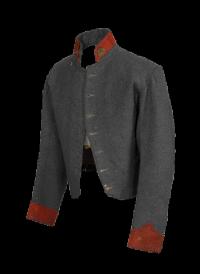Tait uniforms
Published in 18th–19th - Century History, Features, Issue 5 (Sept/Oct 2012), Volume 20
The Tait Confederate uniform jacket on display in the National Museum of Ireland’s Soldiers & Chiefs exhibition in Collins Barracks, Dublin. Note that this example was made in the US from Tait-supplied cloth to a slightly different pattern and has seven rather than the original eight buttons. (National Museum of Ireland)
Sir Peter Tait was born in Scotland in 1828 but moved to Limerick at a young age. At the age of sixteen he became a shop assistant in the Cumine and Mitchell department store but lost his job when trade slackened, forcing him to display the first signs of his entrepreneurial ability. He purchased a basket and went around the city selling goods, mainly shirts, to locals and sailors alike. In 1850 he rented rooms on Bedford Row and took on his first employees in order to increase his shirt production. Within three years he was advertising for 500 additional staff. His pioneering use of the Singer sewing machine allowed him to further increase production, and soon military contracts began to materialise. His most lucrative client was the British Army, particularly during the Crimean War. He produced some 120,000 British uniforms between 1856 and 1858. By then he had moved to larger premises on Edward Street, employing 1,300 staff.Peter Tait’s and Limerick’s connection with the American Civil War began in December 1863, when 50,000 caps, greatcoats, jackets, trousers, shirts, blankets, boots, stockings and haversacks were ordered by the Confederate government. Tait also entered into a separate contract with the state of Alabama in June 1864. In order to fulfil his contracts Tait had to navigate one rather tricky obstacle—the federal blockade of Southern ports. He employed ships such as the Evelyn, which managed to run the blockade five times, with her last departure from Foynes, Co. Limerick, in October 1864; she would not return until September 1865. Another was the Condor, which ran aground off Fort Fisher in North Carolina in late 1864. Though her cargo was safely loaded onto another ship and brought ashore, the famous Confederate agent Rose O’Neal Greenhow, who had been returning from Europe, was drowned.A number of Tait Confederate jackets survive, mainly ones issued late in the war. The surviving examples are of cadet grey kersey with linen lining, and are further identifiable through their eight-button front, with five-piece bodies, two-piece sleeves and wool broadcloth collars. Tait of Limerick buttons—marked ‘P. Tait & Co./Limerick’ on the back—are also regularly recovered by relic-hunters on Civil War battle sites. The most common survivals of both jackets and buttons are in north-east Carolina, and the Petersburg and Appomattox campaigns. Peter Tait continued to prosper despite the defeat of the Confederacy, and he became mayor of Limerick between 1866 and 1868. His association with the city subsequently faded somewhat, however, as he pursued other business ventures abroad. His factory closed in 1875 (although it was later reopened under new management), and Tait himself died in Russia in 1890 while trying to establish a Turkish cigarette factory. His name lives on in Limerick through the Tait Clock, which was built in his honour. As for his Confederate jackets, some are on display in the United States, while one can also be seen in the National Museum of Ireland’s Soldiers and Chiefs exhibition in Collins Barracks, Dublin, where it is on loan from the Museum of the Confederacy. HI
Damian Shiels is editor of http://irishamericancivilwar.com/
















